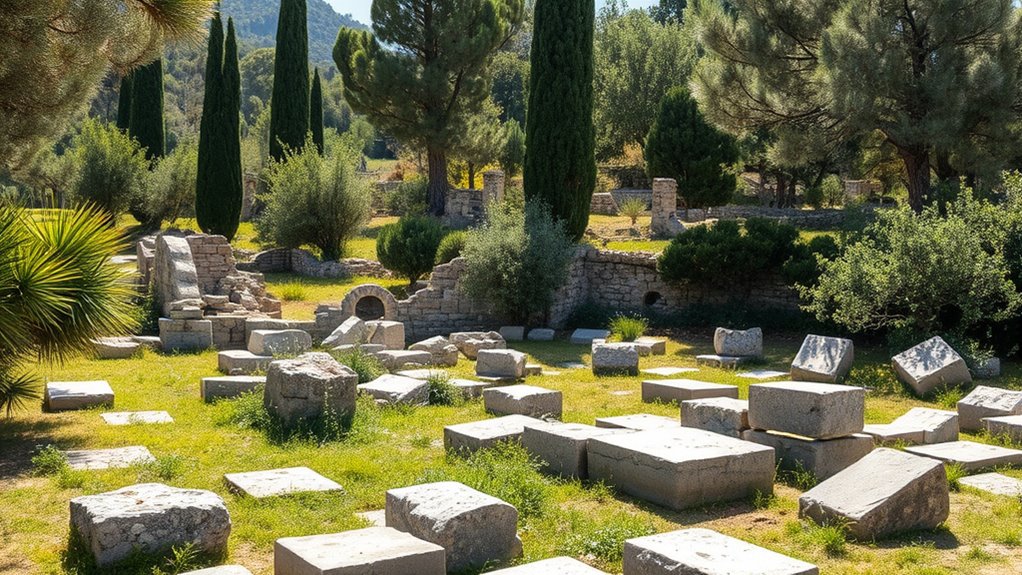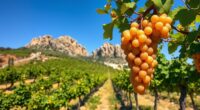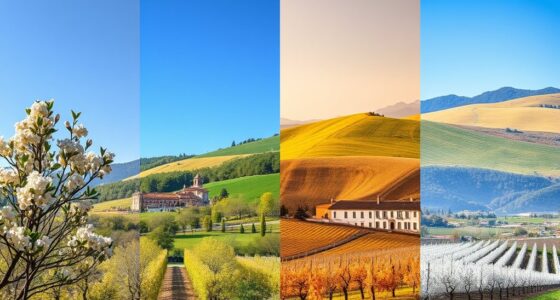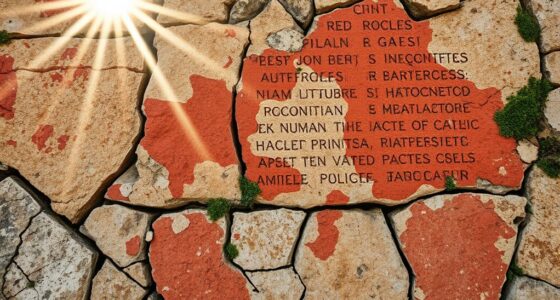If you’re exploring archaeological sites near Ittiri, you’ll find a fascinating mix of prehistoric, Nuragic, Roman, and medieval landmarks set within dramatic volcanic landscapes. Highlights include Sa Figu Necropolis with its ancient hypogea and megalithic circle, Nuragic monuments and tombs showcasing Sardinia’s early history, and religious structures like Nostra Signora di Coros. The rugged terrain and volcanic rocks have helped preserve these sites, offering a rich journey through time. Keep going to uncover even more hidden treasures of this region.
Key Takeaways
- Sa Figu Necropolis, 4 km from Ittiri, features hypogea, megalithic circle, and Nuragic remains spanning multiple prehistoric eras.
- Nuragic monuments near Ittiri include about sixty Nuraghi, sacred wells, and Giants’ tombs, showcasing Sardinia’s Bronze Age culture.
- Monte d’Accoddi, close to Sassari, is a stepped archaeological pyramid used for fertility rituals dating back to 4500-3200 BC.
- Nearby medieval religious monuments display Romanesque-Gothic architecture, serving as spiritual centers with well-preserved structures.
- The volcanic landscape influences site locations, with volcanic rocks and terrain shaping burial practices and archaeological preservation.
Prehistoric Heritage at Sa Figu Necropolis
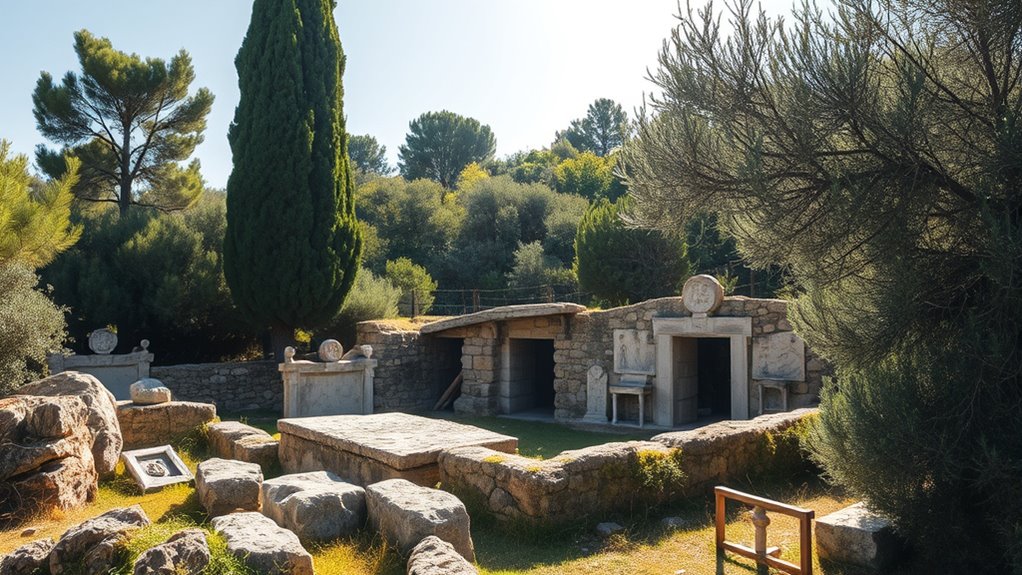
Located just 4 kilometers from Ittiri and accessible via the sanctuary of San Maurizio, Sa Figu Necropolis offers a compelling glimpse into Sardinia’s prehistoric past. You’ll find an archaeological complex featuring eleven hypogea, a megalithic circle, and a protonuraghe, making it the region’s most important prehistoric heritage site. The site spans at least three eras: late Neolithic, Eneolithic/Copper Age, and Late/Mid Bronze Age. You can observe the progression from early domus de janas to Bronze Age megalithic tombs, with some tombs reused into the Iron Age. Architectural features include rock-cut tombs, some remodeled with new façades, and a megalithic circle built from orthostatic boulders. The site also vividly illustrates Sardinia’s evolving funerary traditions and cultural developments over millennia. Additionally, the site’s archaeological features reflect the diverse architectural techniques employed across different prehistoric periods.
Nuragic and Ancient Roman Settlements in the Region
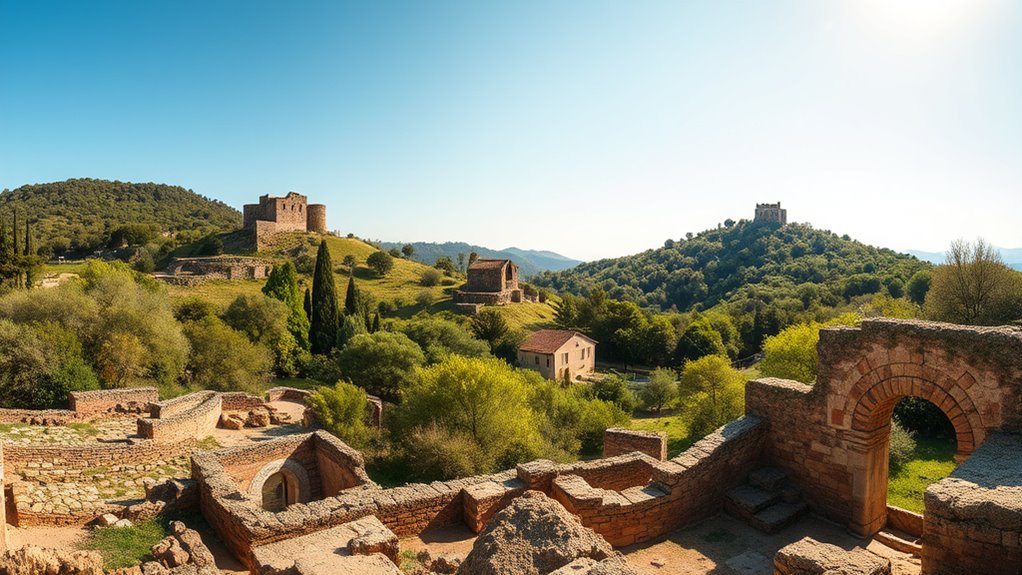
The Ittiri region hosts a rich tapestry of archaeological remains that showcase both Nuragic and Roman influences. You’ll find about sixty Nuraghi here, ranging from simple corridors to complex multi-tower structures, along with sacred wells and Giants’ tombs that reveal advanced social and religious practices. These Nuraghi evolved over several phases, from early proto-nuraghe to later monumental constructions, including megalithic walls and circles. Nearby tombs, like those in Sa Figu necropolis, date back to the Middle Bronze Age and show long-lasting funerary customs, with some reused in Iron Age. Although less prominent, Roman presence is evident through artifacts, pottery, and possible settlements, indicating that the Romans incorporated and built upon existing Nuragic sites, shaping the region’s historical landscape. Roman artifacts and architectural remains also testify to the influence of Roman civilization in the area, blending seamlessly with Nuragic structures to create a layered archaeological record. Additionally, recent excavations have uncovered new urban settlements that suggest a more extensive Roman occupation than previously thought.
Medieval Religious Monuments in Ittiri
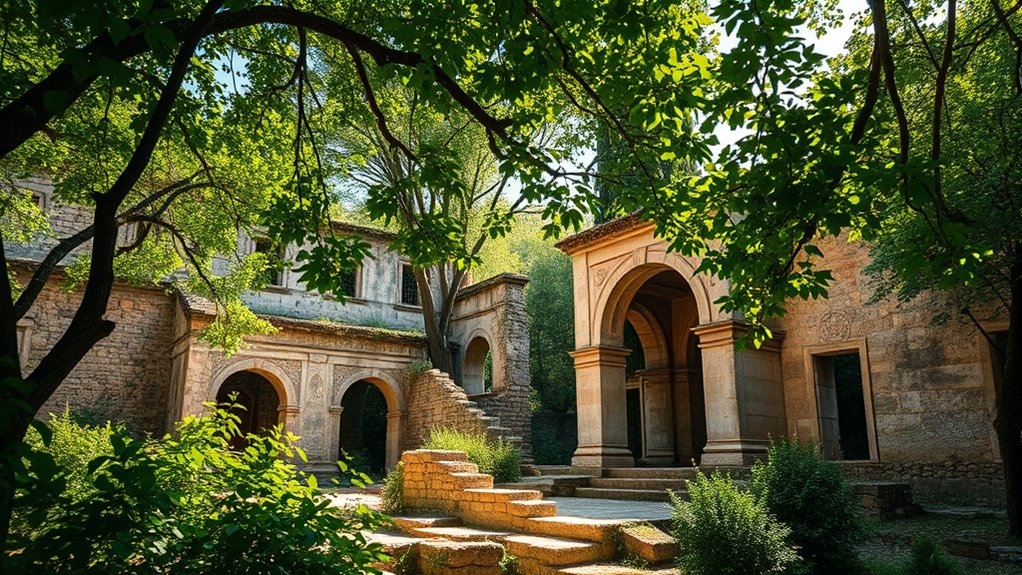
You’ll notice that the medieval religious monuments near Ittiri showcase a blend of Romanesque and Gothic styles, reflecting their historical evolution. These structures served essential spiritual and community roles during the Middle Ages, connecting local faith practices to broader monastic trends. Their architectural details reveal much about the religious life and craftsmanship of that era. Located in Ittiri, Sardinia, as a medieval religious site, they stand as enduring symbols of the region’s historical and spiritual heritage. The architectural features of these monuments also demonstrate the influence of regional construction techniques and artistic traditions that developed over centuries.
Romanesque-Gothic Architecture
Romanesque-Gothic architecture in Ittiri showcases a mesmerizing blend of medieval religious design, reflecting centuries of evolving craftsmanship. You’ll notice the influence of various religious orders, especially the Cistercians, who built structures like churches and abbeys using local limestone. Notable examples include Nostra Signora di Coros, which combines Romanesque features like rounded arches and thick walls with Gothic elements such as pointed arches and ribbed vaults. The layout often includes a nave, transept, and apse, with chapels on each side. Many buildings have undergone restorations, maintaining their original style while blending influences from Pisa, Lombardy, and Provence. These architectural details reveal a rich history of craftsmanship and cultural exchange, making these structures essential to Ittiri’s medieval heritage. These structures also served as important community centers and symbols of local faith during the medieval period. Additionally, the preservation of these monuments demonstrates ongoing efforts to protect and showcase medieval architectural heritage, which continues to attract scholars and tourists alike.
Medieval Religious Significance
Medieval religious monuments in Ittiri reveal the profound influence of the Cistercian Order on Sardinian spiritual life, showcasing structures that served both spiritual and communal purposes. These sites, like the Church of Santa Maria di Coros, highlight the Cistercian impact through their architecture and historical connections. The Church of Our Lady of Paulis, established in 1205, exemplifies Cistercian craftsmanship with limestone walls and a cross-shaped layout. The region’s monastic network expanded from around 1000, integrating Romanesque and Gothic elements over time. These monuments reflect Sardinia’s religious evolution during the Middle Ages, serving as centers of worship, monastic activity, and community life. Today, they remain essential cultural symbols, offering insights into Sardinian history and the enduring legacy of the Cistercian monks.
Volcanic Landscapes and Archaeological Significance
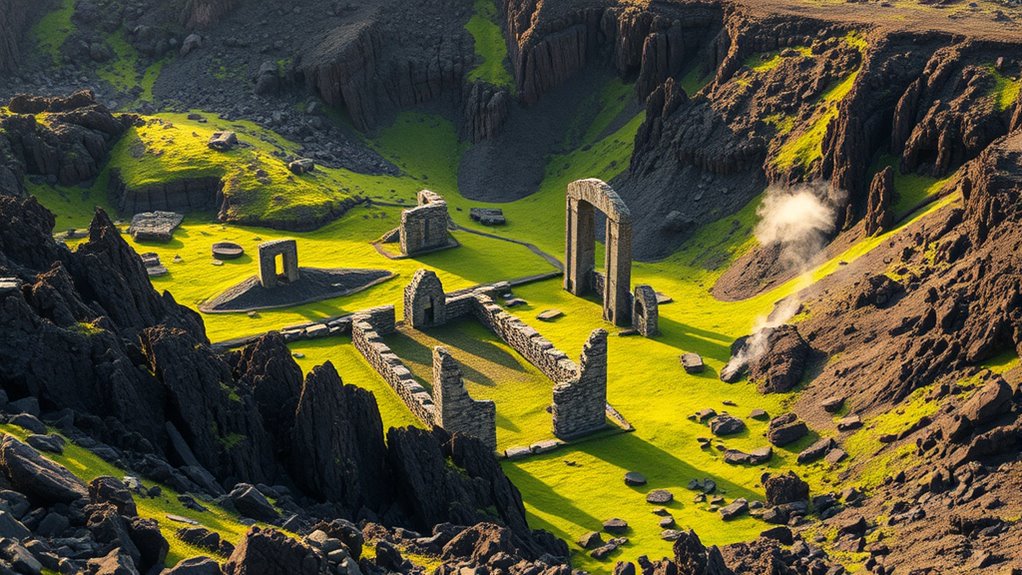
The volcanic terrain around Ittiri directly influenced the location and construction of many archaeological sites, offering natural defense and unique building materials. You’ll notice how ancient communities used volcanic rocks for tombs and structures, shaping their cultural practices. These landscapes continue to reveal how geology and human activity are closely connected through history. Additionally, the integration of automation technologies in archaeological research has enhanced the ability to analyze and preserve these sites more effectively.
Volcanic Terrain Shaping Sites
Mount Torru’s volcanic terrain has played a crucial role in shaping the archaeological landscape near Ittiri. The landscape features striking golden volcanic rocks, sinuous ridges, and volcanic plateaus blending volcanic and calcareous rocks. These rugged ridges create semi-desert valley-like vistas reminiscent of North America, offering both beauty and challenge. Human settlements, including nuraghi and prehistoric sites, are nestled within valleys formed by volcanic activity, demonstrating long-term adaptation. The elevated ridges provided strategic advantages for defense and settlement, influencing where ancient communities built. The volcanic rocks also helped preserve archaeological remains by resisting weathering and limiting agricultural disturbance. Additionally, the volcanic activity contributed to the formation of mineral-rich soils that supported early agriculture and settlement sustainability. This geological influence continues to impact the preservation and discovery of archaeological remains today. Overall, the volcanic terrain’s unique topography and resilient materials created a protective environment, shaping the placement, preservation, and significance of archaeological sites near Ittiri.
Geology and Burial Practices
Volcanic landscapes near Ittiri have profoundly shaped burial practices and their archaeological significance. The geology provides stable volcanic horizons ideal for urn placement and tomb preservation, influencing site layout and distribution. Durable volcanic rock materials are preferred for hypogea and megalithic tombs, ensuring longevity. Burial sites often align with specific volcanic strata, reflecting landscape stability and visibility for ceremonies. The terrain’s natural features also inform the spatial organization and ritual importance of burial locations. Non-invasive geophysical methods, like ground-penetrating radar, help map tombs without damage, revealing hidden chambers beneath volcanic deposits. These practices demonstrate how geology directly affects burial customs, blending natural landscape with cultural symbolism, and highlight the adaptive strategies of ancient communities near Ittiri in shaping their death rituals within volcanic terrains.
Notable Nearby Archaeological Landmarks
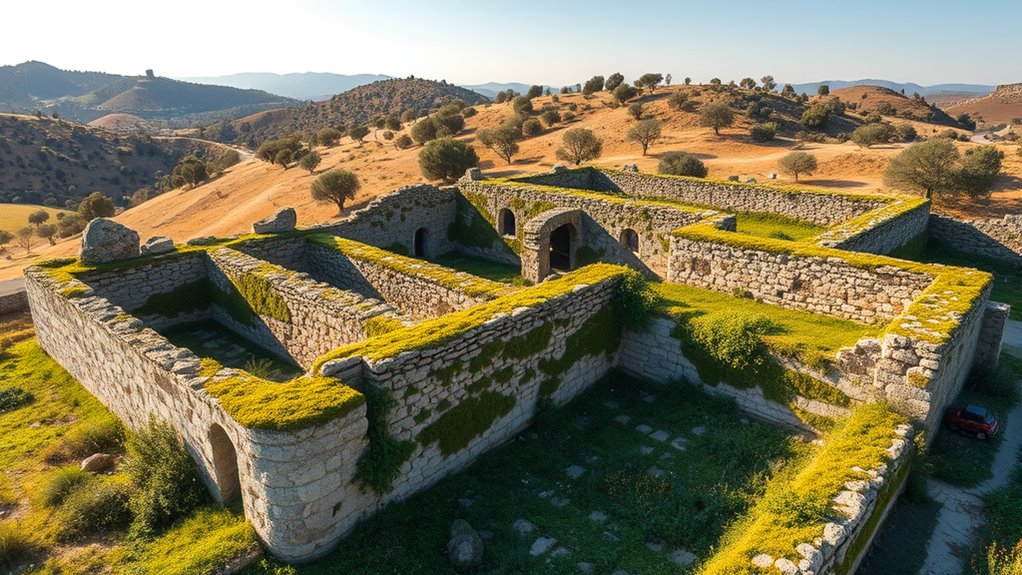
Exploring the archaeological landmarks near Ittiri reveals a rich tapestry of prehistoric and medieval heritage. Notable sites include:
- Sa Figu Necropolis – just 4 km from Ittiri, this site blends prehistoric and Nuragic remains, featuring hypogea, a megalithic circle, and the base of an archaic Nuraghe, spanning late Neolithic to Bronze Age eras. Its extensive burial chambers and ceremonial areas provide insight into early Sardinian spiritual practices. prehistoric burial customs
- Nuragic Monuments in Coros – this region showcases Nuragic structures like protonuraghe remnants, ancient settlements, and ritual centers that reflect the complex society of the Nuragic tribes.
- Monte d’Accoddi – near Sassari, this 4500-3200 BC stepped pyramid served as a fertility ritual site, revealing some of Sardinia’s oldest spiritual monuments.
These landmarks highlight Sardinia’s layered prehistoric and medieval past, waiting to be explored.
Exploring Archaeological Sites: Trails and Visitor Tips
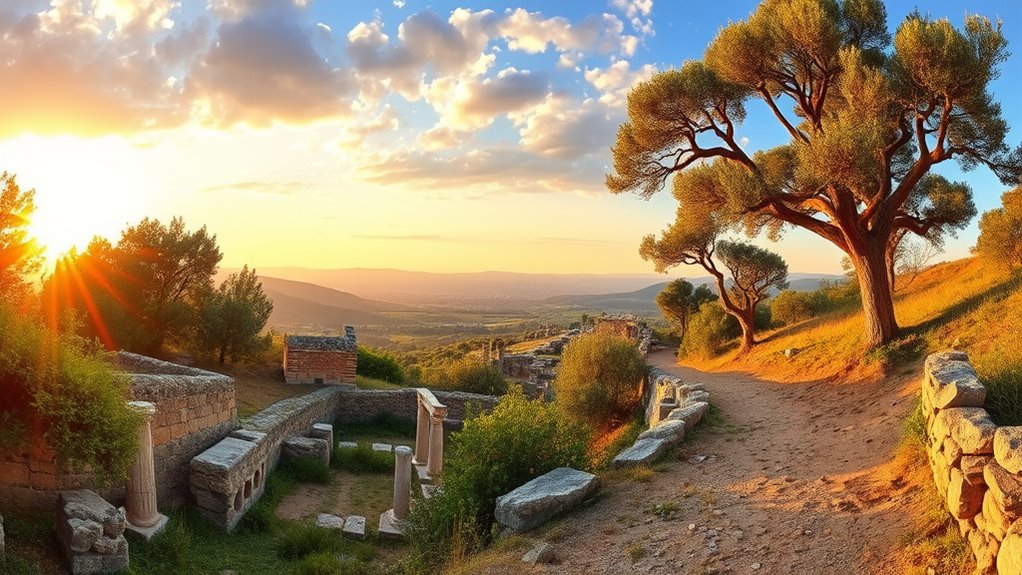
Visiting archaeological sites near Ittiri offers a fascinating glimpse into Sardinia’s ancient past, but it’s important to approach these locations with respect and awareness. Stick to marked trails and posted signs to protect fragile structures and artifacts. Use designated paths to minimize impact and avoid walking on or climbing ancient features, which can cause irreversible damage. Always follow site guidelines and refrain from digging, metal detecting, or removing artifacts—they’re illegal and harm the site’s integrity. Respect cultural sensitivities and local traditions by acting quietly and refraining from graffiti or disruptive behavior. Wear suitable footwear and stay alert for uneven terrain or unstable structures. Supporting guided tours and local businesses enhances your experience while promoting sustainable tourism and site preservation. Engaging with cultural heritage and understanding its significance helps preserve these valuable archaeological resources for future generations.
Frequently Asked Questions
Are Archaeological Sites in Ittiri Accessible for People With Limited Mobility?
You’re wondering if archaeological sites in Ittiri are accessible for people with limited mobility. Currently, most sites pose challenges like uneven paths, steep slopes, and no ramps or nearby parking. While some areas offer guided hikes, there are no dedicated infrastructure adaptations. To improve accessibility, consider adding ramps, tactile guides, and accessible facilities, or explore virtual experiences as alternatives. Ongoing mapping and planning can help make these sites more inclusive for everyone.
What Are the Best Times of Year to Visit Ittiri’S Archaeological Sites?
You’ll get the best experience visiting Ittiri’s archaeological sites during spring (April to June) and early autumn (September to October). During these times, the weather is mild, with fewer tourists, making exploration more comfortable and enjoyable. Avoid the hot summer months, which can be strenuous, and the rainy winter season that might limit access. Planning your visit during these ideal seasons ensures better weather, safety, and a more immersive experience.
Are Guided Tours Available at All Major Prehistoric and Medieval Sites?
Guided tours are available for some major prehistoric and medieval sites, but options vary. You’ll find well-organized, expert-led hikes at prehistoric locations like Mount Torru, offering in-depth insights. Medieval sites often have less formal guidance, sometimes with volunteer or local guides, but routine tours aren’t always offered. To guarantee a guided experience, it’s best to contact local tour providers or tourist offices in advance to arrange your visit.
How Long Does It Typically Take to Explore the Sa Figu Necropolis Fully?
Imagine walking through a centuries-old labyrinth, each turn revealing new secrets—exploring Sa Figu Necropolis is similar. It usually takes 2 to 4 hours to fully appreciate its size and complexity, including various tombs, architectural features, and artifacts. Your visit involves climbing to the plateau, studying detailed sculptures, and absorbing history. Rushing isn’t ideal; a thorough exploration needs patience, curiosity, and about half a day to truly experience its ancient stories.
Are There Any Restrictions on Photography or Drone Use at These Archaeological Locations?
You should know there are restrictions on photography and drone use at archaeological sites. You can’t fly drones or take professional photos without permission from heritage authorities. Unauthorized drone flights can lead to fines or equipment confiscation. Always check with site officials beforehand, follow signage, and respect rules to safeguard the site’s integrity. Using designated areas for photography and obtaining proper permits ensures you enjoy your visit responsibly and legally.
Conclusion
Discovering archaeological sites near Ittiri offers a fascinating glimpse into Sardinia’s rich history, from prehistoric tombs to Roman ruins. Did you know that over 7,000 Nuragic monuments dot the island? Exploring these sites not only connects you to the past but also reveals the island’s cultural diversity. So, lace up your hiking boots and immerse yourself in these timeless landmarks—you’re about to uncover stories that shaped Sardinia’s ancient heritage.
